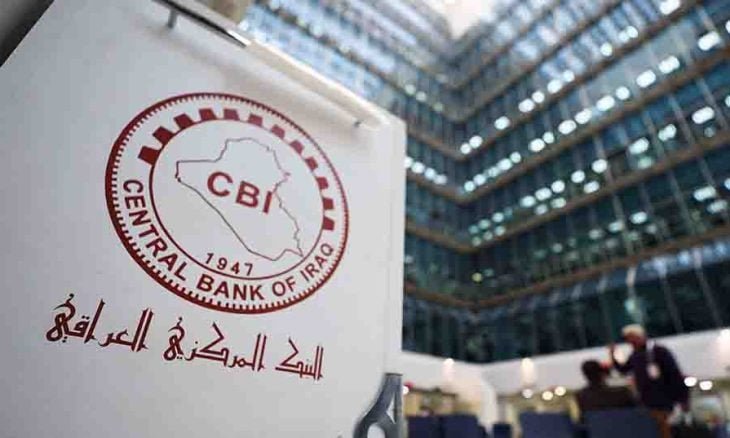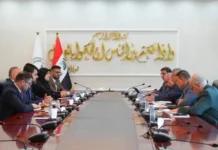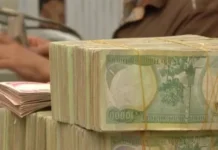
In spite of numerous warnings and concerns, Iraqi banks are rapidly declining towards the same fate as the bankrupt Lebanese banks. This is due to the government’s confusion in managing the crisis of the plummeting dollar exchange rates, as well as the persistence of corruption mafias in Aleppo and the smuggling of dollars from the Iraqi market to serve well-known regional agendas.
A meeting was held by Prime Minister Muhammad Shiaa Al-Sudani with bank executives to address the increase in the dollar exchange rate and simplify banking procedures.
The Media Office of the Prime Minister released a statement stating that Al-Sudani led a meeting last Sunday where the Governor of the Central Bank and directors of government banks were present. The meeting discussed the procedures and mechanisms required for banking reform. The Prime Minister emphasized that financial reform is more than just a slogan and laid out the terms and procedures that the government intends to implement. He directed the simplification of all banking procedures and the identification of obstacles that hinder the banking reform process.
Al-Sudani made some statements following warnings by financial experts of the repercussions that could arise from the failure of procedures and instructions issued by the Central Bank of Iraq to control the continuous rise in the dollar exchange rate in the parallel market. In addition, Representative Raad Al-Dahlaki, a member of the Parliamentary Integrity Committee, confirmed that the government, central bank and parties all share responsibility for the dollar crisis, and expects exchange rates to continue rising.
Al-Dahlaki expressed concern that the current indicators do not suggest a decline in the price of the dollar and that we may instead witness a gradual rise in its price. He further explained that the lack of a clear strategy to restore the dollar to its previous value along with the improper implementation of official procedures are the main factors contributing to this issue. He emphasized that he does not wish to create any crisis or frustration in the market.
Numerous banks in the capital witnessed gatherings of angry citizens who were protesting against the banks for not allowing them to withdraw their deposits in dollars. The banks were citing the instructions from the Central Bank that prohibited the withdrawal of deposits in dollars and instead, compensating them in dinars at the official exchange rate of 1,320 dinars per dollar. However, the current price of the dollar in the parallel market is around 1,600 dinars, which is causing distress among the depositors.
Several events occurred simultaneously in Baghdad, including a demonstration by exchange company owners on Al-Rashid Commercial Street. They demanded the dismissal of corrupt officials within the Central Bank, an end to the rise in dollar exchange rates, and the control of private bank mafias in the market. As a result of the instability in the currency exchange market, many banking company owners across the city and provinces closed their shops and ceased selling operations. This led to a significant increase in the dollar exchange rates.
While touring some banks in the Iraqi capital with “Al-Quds Al-Arabi,” I noticed that certain banks were only providing dollars to travelers, while others had set a limit of 1,000 US dollars for withdrawals from remittances. TBI Bank was also delivering external transfers in dollars, but only to a limited number of customers with low ceilings.
High dollar prices in the market
Saad Al-Obaidi, a businessman, informed Al-Quds Al-Arabi that he withdrew all his dollar deposits from his accounts in Al-Rafidain and Al-Rashid banks after a Central Bank official’s statements. He expressed his concern about a possible repeat of the Lebanese bank bankruptcy scenario, which he believes is likely. He added that merchants and company owners do not trust the procedures of the Central Bank and banks in Iraq. These institutions were characterized by chaos, lack of planning, and corruption, which led to a rise in the dollar’s price in the market. According to him, there are strong concerns and fears that the banks will seize customers and companies’ deposits in dollars and compensate them in dinars and at the official rate, which is much lower than the real parallel market. This causes significant losses to depositors, especially merchants and companies. Al-Obaidi believes that what the government banks are doing is killing the citizen’s confidence in them. Preventing citizens from recovering their money deposited in the banks is entirely unacceptable. This action will lead to the citizens withdrawing all of their deposits in dollars from Iraqi banks.
The recent remarks made by Mazen Sabah Ahmed, Director of Foreign Remittances at the Central Bank, regarding dollar deposits in banks have sparked outrage among the public. In a statement to Reuters, he stated that individuals who deposit dollars in banks before the end of 2023 will be able to withdraw them in the same currency until 2024. However, any dollars deposited in 2024 or later can only be withdrawn in the local currency at the official exchange rate of 1,320 dinars to the dollar. He also emphasized that the Central Bank is not obliged to convert incoming transfers into cash dollars and deliver them in that form. These measures are intended to prevent the use of dollar currency by unauthorized parties or for speculative purposes.
The Central Bank has implemented various measures to regulate the price and movement of the dollar in the parallel market. To achieve this, it has stopped the usage of certain financial institutions such as Western Union, MoneyGram, Zain Cash, and others. Additionally, three months ago, the bank had prohibited the distribution of dollars to customers via ATM machines.
Last April, the Iraqi Council of Ministers issued a decision that requires all companies and banks to conduct their transactions using the dinar only, including the salaries of employees of foreign companies who were previously paid in dollars. The official exchange rate for the dinar is 1,320, except for diplomatic missions, which are paid in dollars.
Failure of central bank measures
Economists unanimously agreed that the measures taken by the Central Bank to combat the rise in the exchange rate of the dollar in the parallel market were counterproductive.
According to economist Dr. Nabil Al-Marsoumi, the recent increase in the value of the dollar is a complicated economic and political issue that cannot be solved by the Central Bank of Iraq alone. The ultimate goal is to hinder trade between Iraq and Iran, which amounts to about 10 billion dollars annually. The U.S. Treasury has a representative stationed at the embassy in Baghdad to monitor currency exchange operations and ensure that the money is not being transferred to Iran. Iran wants to receive its payments in dollars through banks in the Emirates and elsewhere, and Iraqi travelers, patients, and tourists also require dollars. Iraqi tourists make up about 55 percent of tourism in Iran and spend around 3 billion dollars annually.
Al-Marsoumi has issued warnings about the increasing gap between the official and parallel prices of the dollar. This gap is having negative consequences on the Iraqi economy. He revealed that there is an external variable impacting the exchange rate, which is the American restrictions on the movement of the dollar in Iraq to prevent it from reaching Iran. Al-Marsoumi indicated that if the growing gap between the official and parallel prices of the dinar against the dollar is not neutralized or reduced, it could pose a danger to the political system and the Iraqi government. He also expects the crisis of the large difference in exchange rates to continue when the government launches the budget disbursement. This will lead to a significant increase in spending and trade and will lead to an increase in demand for the dollar in the market. Regarding the prospects for resolving the crisis, Al-Marsoumi stressed that the solution lies in cutting off Iraq’s trade with Iran or Washington abolishing the sanctions on Iran. However, both of these options are currently unthinkable, so the crisis will continue now and in the future. Al-Marsoumi also acknowledged that the smuggling of dollars from Iraq has been continuing since 2003.
According to advisors to the Sudanese government, the United States of America issued clear public warnings on eight separate occasions against the continued large-scale sale of dollars through the Central Bank’s currency auction window. The US provided evidence that the majority of dollar buyers were smuggling it to Iran, Syria, and Lebanon. Following this, Washington imposed sanctions on 18 Iraqi banks, prohibiting them from dealing in dollars. Iraqi banks had become a crucial financial channel for Iran, which was already subject to US sanctions.
Economic experts agree that the government of Muhammad Shiaa al-Sudani failed to control the dollar exchange rate, which is the most crucial economic aspect. Despite numerous statements and promises made by the government and the change of the Central Bank governor, all of these measures had a negative impact on the rise of the dollar value and the collapse of the Iraqi dinar. Some pointed out that the Baghdad government claims to have control over the smuggling of dollars to Iran, but this claim is unreasonable given the American ability to detect the movement of the dollar worldwide. It is believed that the parties in power in Baghdad are risking the interests of the Iraqi economy for the benefit of their allies in Tehran. Iraq is expected to face American sanctions, and the fate of the Iraqi economy could be the same as that of Lebanon, which collapsed due to the same scenario, way out, and tools.




